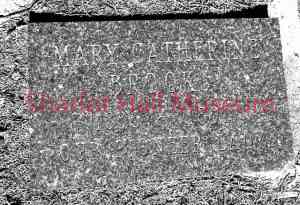By Barbara Patton
This week’s article continues a look back at some of the early women settlers in Prescott. One of them was Mary Catherine Leib Brooks.
 Mary Catherine, a small, refined lady, arrived with her husband, Dr. Charles Leib, in Central Arizona in late 1863. Dr. Leib was attached to the first military party at Fort Whipple. Mary was a devoted wife to accompany her husband to such a remote outpost, especially since she was likely the only woman in a group of military men.
Mary Catherine, a small, refined lady, arrived with her husband, Dr. Charles Leib, in Central Arizona in late 1863. Dr. Leib was attached to the first military party at Fort Whipple. Mary was a devoted wife to accompany her husband to such a remote outpost, especially since she was likely the only woman in a group of military men.
A few months after their arrival, Dr. Leib, a man of dubious medical credentials, was relieved of duty and he and Mary Catherine moved into Prescott. Within a month or two, trying his political luck, Dr. Leib ran against Charles Poston for the position of territorial delegate to Congress and was soundly defeated. In January, 1865, he died of an unspecified illness.
Though misfortune had fallen on her husband, Mary Catherine chose to stay in Prescott and continue running the boarding house she and Charles had started. Over the next couple of years, she became better acquainted with her handsome next-door neighbor, Hezekiah Brooks, a gentleman destined to become a pillar of the community. Mary and Hezekiah were married in 1867 and she moved into his larger home. Using her gardening skills, Mary created a large garden and orchard. Visitors to their home often received apples or pastries sweetened with fruit.
Mary Catherine unobtrusively became a treasured member of the growing community of pioneers. During her first years in Prescott, she provided classes for children in her own cabin on Granite Creek, and later helped organize and teach the first Sunday school in town.
Since Mary and Hezekiah were childless, they welcomed the opportunity to adopt an orphaned Indian child whose mother had been killed in a military raid. The child was about two years old when they took her in and named her Bessie. Although there were challenges at first, Bessie ultimately settled into a loving home.
Mary was very hospitable and welcomed other settlers as they began to arrive in Prescott. All the women settlers brought something to the community, including good character, useful skills or scarce household items.
 For example, in July of 1864, Margaret Ehle and her large family arrived. Margaret was already a seasoned pioneer and knew what would be useful in a frontier town. Some of the firsts she brought to Prescott were a yellow house cat whose kittens were highly coveted, several Spanish hens, a pretty “Bouncing Bet” plant and a Grover and Baker sewing machine. Margaret was also a skilled midwife, lending her knowledge to the limited medical resources of the fledgling town.
For example, in July of 1864, Margaret Ehle and her large family arrived. Margaret was already a seasoned pioneer and knew what would be useful in a frontier town. Some of the firsts she brought to Prescott were a yellow house cat whose kittens were highly coveted, several Spanish hens, a pretty “Bouncing Bet” plant and a Grover and Baker sewing machine. Margaret was also a skilled midwife, lending her knowledge to the limited medical resources of the fledgling town.
In the summer and fall of 1864, several more women arrived with families - Perlina Osborn, Lois Boblett, Catharine Alexander, Nancy Stephens. All supported the community, if only by helping neighbors in need or by running make-shift restaurants in their homes to serve members of the first Legislature.
The next year, in 1865, Harriet Turner, wife of Chief Justice William Turner, arrived. Harriet became a close friend of Mary Catherine Brooks and helped her with her school. Later they were both involved with the establishment of Arizona’s first Methodist Church.
These early women settlers were the first, but not the last, to contribute to Prescott’s growth by supporting their families, neighbors and community.
“Days Past” is a collaborative project of the Sharlot Hall Museum and the Prescott Corral of Westerners International (www.prescottcorral.org). This and other Days Past articles are also available at archives.sharlothallmuseum.org/articles/days-past-articles/1 The public is encouraged to submit proposed articles and inquiries to dayspast@sharlothallmuseum.org Please contact SHM Research Center reference desk at 928-277-2003, or via email at archivesrequest@sharlothallmuseum.org for information or assistance with photo requests.


